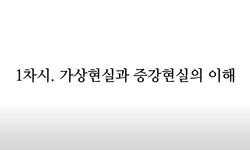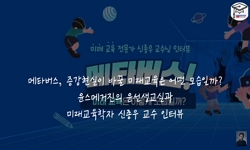건설 현장과 같은 위험한 환경에서 작업자를 위한 솔루션으로 원격 조작 기술이 활용되고 있다. 원격 조작은 위험 지역에서 멀리 떨어져 작업을 수행하기 때문에 안전성을 향상시킬 수 있다...
http://chineseinput.net/에서 pinyin(병음)방식으로 중국어를 변환할 수 있습니다.
변환된 중국어를 복사하여 사용하시면 됩니다.
- 中文 을 입력하시려면 zhongwen을 입력하시고 space를누르시면됩니다.
- 北京 을 입력하시려면 beijing을 입력하시고 space를 누르시면 됩니다.
원격 조작 시 AR 인터페이스가 거리 지각에 미치는 영향 = The Effects of AR Interface on Distance Perception in Teleoperation
한글로보기부가정보
국문 초록 (Abstract)
이를 위해 RC 장난감를 활용한 원격 환경에서 AR 인터페이스를 구현하였으며, 40명의 연구 참가자를 대상으로 과업을 수행하였다. 뷰 인터페이스 조건과 AR 시각적 단서의 Line density 수준에 따라 총 12가지 실험 조건을 설계하였으며 거리 추정 오차, 과업 수행 시간, 작업 부하를 평가하여 거리 지각을 향상시킬 수 있는 방식을 확인하였다.
연구 결과, Multi-view 인터페이스는 거리 지각을 향상시켰으며, 특히 Overhead-view일 때 가장 높은 거리 지각을 확인하였다. 이는 원격 조작 시 작업 효율성을 향상시키는 Multi-view의 필요성을 강조한다. 또한 AR 시각적 단서의 Line density는 높을수록 거리 지각에 긍정적인 영향을 미쳤으나, 일정 수준 이상의 조건에서는 유의미한 차이를 나타내지 않았다. 이를 통해 원격 환경에서 AR 시각적 단서 설계 시 적정 밀도 수준을 고려해야 하며, 필요 이상의 정보 제공이 항상 거리 지각을 향상시키지 않을 수 있음을 시사한다.
본 연구 결과를 통해 원격 조작 시 거리 지각 향상을 지원하는 AR 인터페이스 설계 방향을 제시하며, 건설 분야를 포함한 다양한 원격 작업 환경에서 인터페이스 기초 자료로 활용될 수 있을 것으로 기대된다.
건설 현장과 같은 위험한 환경에서 작업자를 위한 솔루션으로 원격 조작 기술이 활용되고 있다. 원격 조작은 위험 지역에서 멀리 떨어져 작업을 수행하기 때문에 안전성을 향상시킬 수 있다. 하지만 시각적 제약으로 인해 작업 환경 내 지형 및 장애물 등의 위치, 거리를 정확하게 판단하는 능력이 저하된다. 이를 해결하기 위해 증강 현실 기술이 도입되어 사용자의 공간 인식을 향상시키고 있으나, 과도한 정보 제공으로 인해 사용자의 혼란을 야기하고 있다. 이에 따라, 본 연구는 원격 조작 시 AR 인터페이스의 설계 요소가 거리 지각에 미치는 영향을 분석하고자 한다. 거리 지각을 향상시킬 수 있는 Multi-view 인터페이스와 AR 시각적 단서를 통해 거리 지각에 미치는 영향을 평가함으로써 사용자의 작업 부하를 낮추면서 거리 인식을 효과적으로 지원할 수 있는 적정 수준을 탐색하고자 한다.
이를 위해 RC 장난감를 활용한 원격 환경에서 AR 인터페이스를 구현하였으며, 40명의 연구 참가자를 대상으로 과업을 수행하였다. 뷰 인터페이스 조건과 AR 시각적 단서의 Line density 수준에 따라 총 12가지 실험 조건을 설계하였으며 거리 추정 오차, 과업 수행 시간, 작업 부하를 평가하여 거리 지각을 향상시킬 수 있는 방식을 확인하였다.
연구 결과, Multi-view 인터페이스는 거리 지각을 향상시켰으며, 특히 Overhead-view일 때 가장 높은 거리 지각을 확인하였다. 이는 원격 조작 시 작업 효율성을 향상시키는 Multi-view의 필요성을 강조한다. 또한 AR 시각적 단서의 Line density는 높을수록 거리 지각에 긍정적인 영향을 미쳤으나, 일정 수준 이상의 조건에서는 유의미한 차이를 나타내지 않았다. 이를 통해 원격 환경에서 AR 시각적 단서 설계 시 적정 밀도 수준을 고려해야 하며, 필요 이상의 정보 제공이 항상 거리 지각을 향상시키지 않을 수 있음을 시사한다.
본 연구 결과를 통해 원격 조작 시 거리 지각 향상을 지원하는 AR 인터페이스 설계 방향을 제시하며, 건설 분야를 포함한 다양한 원격 작업 환경에서 인터페이스 기초 자료로 활용될 수 있을 것으로 기대된다.
다국어 초록 (Multilingual Abstract)
This study investigates the influence of AR interface design elements on distance perception during teleoperated operations in construction environments. In particular, it examines the impact of multi-view interfaces and AR visual cues on distance perception, aiming to determine the optimal level of information that enhances spatial awareness while minimizing operator workload.
To achieve this, an AR interface was implemented in a teleoperation system using an excavator, and experiments were conducted with 40 participants. A total of 12 experimental conditions were designed, varying in interface configurations and densities of AR visual cue lines. The study evaluated distance estimation errors, task completion times, and operator workloads to identify the most effective strategies for improving distance perception.
The results indicated that multi-view interfaces significantly enhanced distance perception, with the overhead view yielding the highest accuracy. These findings underscore the importance of multi-view configurations in improving operational efficiency during teleoperated tasks. Furthermore, while higher levels of AR visual cue line density positively influenced distance perception, the effect plateaued beyond a certain threshold, showing no further improvement. This suggests that AR visual cues in teleoperation systems should be carefully optimized to prevent excessive information that may not contribute to enhanced distance perception.
The findings of this study provide valuable design guidelines for AR interfaces to support distance perception in teleoperation systems. These results are expected to serve as foundational data for interface development in various teleoperation applications, including the construction industry.
The use of teleoperation technology has become a prevalent method for ensuring the safety of workers in hazardous environments, such as construction sites, by enabling operations to be conducted from a safe distance. However, visual limitations often ...
The use of teleoperation technology has become a prevalent method for ensuring the safety of workers in hazardous environments, such as construction sites, by enabling operations to be conducted from a safe distance. However, visual limitations often hinder operators from accurately perceiving the position and distance of terrain and obstacles within teleoperated workspaces. To address these challenges, augmented reality (AR) technology has been introduced to enhance operators’ spatial awareness. Nevertheless, the excessive information presented through AR interfaces can lead to workload and operator confusion.
This study investigates the influence of AR interface design elements on distance perception during teleoperated operations in construction environments. In particular, it examines the impact of multi-view interfaces and AR visual cues on distance perception, aiming to determine the optimal level of information that enhances spatial awareness while minimizing operator workload.
To achieve this, an AR interface was implemented in a teleoperation system using an excavator, and experiments were conducted with 40 participants. A total of 12 experimental conditions were designed, varying in interface configurations and densities of AR visual cue lines. The study evaluated distance estimation errors, task completion times, and operator workloads to identify the most effective strategies for improving distance perception.
The results indicated that multi-view interfaces significantly enhanced distance perception, with the overhead view yielding the highest accuracy. These findings underscore the importance of multi-view configurations in improving operational efficiency during teleoperated tasks. Furthermore, while higher levels of AR visual cue line density positively influenced distance perception, the effect plateaued beyond a certain threshold, showing no further improvement. This suggests that AR visual cues in teleoperation systems should be carefully optimized to prevent excessive information that may not contribute to enhanced distance perception.
The findings of this study provide valuable design guidelines for AR interfaces to support distance perception in teleoperation systems. These results are expected to serve as foundational data for interface development in various teleoperation applications, including the construction industry.
목차 (Table of Contents)
- 제1장 서론
- 1.1. 연구 배경
- 1.2. 연구 목적
- 제2장 이론적배경
- 제1장 서론
- 1.1. 연구 배경
- 1.2. 연구 목적
- 제2장 이론적배경
- 2.1. 원격 조작(Teleoperation)
- 2.1.1. 원격 조작의 도입
- 2.1.2. 건설 환경에서의 원격 조작
- 2.2. 거리 지각
- 2.2.1. 거리 지각과 시각적 단서
- 2.2.2. 원격 조작 환경에서 거리 지각
- 2.2.3. 거리 지각 측정 방법
- 2.3. 증강 현실(Augmented Reality)
- 2.3.1. 증강 현실과 시각화 특성
- 2.3.2. 증강 현실이 원격 조작 환경에 미치는 영향
- 2.3.3. 거리 지각을 높이는 AR 시각적 단서
- 2.3.4. Multi-view 인터페이스
- 제 3 장 연구 방법
- 3.1. 가설
- 3.2. 실험 설계
- 3.2.1. 독립 변수
- 3.2.2. 종속 변수
- 3.3. 실험 구성
- 3.3.1. 연구 참가자
- 3.3.2. 자극물 디자인
- 3.3.3. 실험 환경
- 3.4. 실험 절차
- 3.5. 자료 수집 및 분석
- 제 4 장 연구 결과
- 4.1. 설문 문항 타당성 검증
- 4.2. 정규성 검증
- 4.3. 가설 검정
- 4.3.1. Multi-view 인터페이스 제공 여부에 따른 거리 지각
- 4.3.2. Multi-view 인터페이스 관점에 따른 거리 지각
- 4.3.3. AR 시각적 단서의 Line density에 따른 거리 지각
- 4.4. 사후 인터뷰 결과
- 4.4.1. 선호도 순위 평가 결과
- 4.4.2. 반구조화 인터뷰 결과
- 제5장 논의
- 5.1. Multi-view 인터페이스 제공
- 5.2. Multi-view 인터페이스 관점
- 5.3. AR 시각적 단서의 Line density
- 제6장 결론
- 6.1. 연구의 의의
- 6.2. 연구의 한계점
- 6.3. 추후 연구












